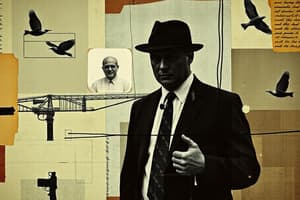Podcast
Questions and Answers
What is associative evidence?
What is associative evidence?
The physical evidence found at the scene that could link the identity by means of clue material, personal property, or characteristics pattern.
What is tracing evidence?
What is tracing evidence?
Physical evidence that may assist the investigating officer in locating the suspect.
What comprises corpus delicti evidence?
What comprises corpus delicti evidence?
Objects or substances that may be parts of the body of the crime, the victim, or the suspect.
What is a sworn statement?
What is a sworn statement?
The heading of a sworn statement contains the full name and __________ of the person giving the statement.
The heading of a sworn statement contains the full name and __________ of the person giving the statement.
What is the main purpose of shadowing or tailing?
What is the main purpose of shadowing or tailing?
Which of the following is NOT an objective of surveillance?
Which of the following is NOT an objective of surveillance?
The surveillant should be patient, resourceful, versatile, and __________.
The surveillant should be patient, resourceful, versatile, and __________.
Which is NOT a precaution for a surveillant during surveillance?
Which is NOT a precaution for a surveillant during surveillance?
Flashcards are hidden until you start studying
Study Notes
Associative Evidence
- Physical evidence found at a crime scene that can link a suspect
- Examples include personal property, clues, and patterns of procedure
Tracing Evidence
- Evidence used to locate a suspect
Corpus Delicti Evidence
- Objects or substances that are part of the crime, such as:
- Weapons
- Body fluid
- Fingerprints
- Footprints
Sworn Statement
- A written version of an interview or interrogation
- Important element of an investigation
- Two main components:
- Heading: Contains the names of the person giving the statement and the investigator, date, time, and place.
- Initial Question: Informs the suspect of their legal rights and asks if they are willing to give a statement freely
The Second Phase of Criminal Investigation: Trace and Locate the Criminal
- Involves finding and apprehending the offender
- Techniques used to locate and apprehend suspects:
- Informants
- Surveillance
- Undercover assignments
Surveillance
- Discreet observation of people, places, and vehicles to gather information about their identities or activities
- Can be used:
- To detect criminal activity
- To identify people who frequent a location
- To discern the habits of an individual
- To obtain evidence of a crime or prevent future crimes
Shadowing or Tailing
- Following a person
- Objectives:
- Detect criminal activities
- Establish a suspect's associations
- Locate a wanted person
- Protect a witness
General Personnel Qualifications for Surveillance
- Patience
- Resourcefulness
- Versatility
- Alertness
- Complete knowledge of the investigation
- Self-control
General Surveillance Procedures:
- Identify the subject
- Choose appropriate attire
- Take precautions:
- Avoid sudden movements
- Do not use exaggerated disguises
- Never stare directly at the subject
- Never make eye contact with the subject
- Walk near the curb to avoid being caught in doorways or alleys
- Be cautious in dark alleys
- Do not speak or recognize other surveillants unless the mission is complete
- Resist the urge to believe you have been spotted if the subject glances in your direction several times
Studying That Suits You
Use AI to generate personalized quizzes and flashcards to suit your learning preferences.




